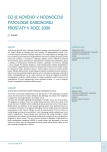PATHOLOGY OF THE PROSTATE AND ANDROGEN AND ESTROGEN LEVELS
Authors:
prof. MUDr. Rajko Doleček; DrSc. 1; MUDr. Jan Krhut 2; MUDr. David Němec 2
Authors‘ workplace:
Interní klinika FNsP Ostrava
1; urologické oddělení FNsP Ostrava
2
Published in:
Urol List 2006; 4(4): 38-44
Overview
127 men aged 40 - 49, 50 - 59, 60 - 60, and over 70 were examined, of whom 64 were without prostatic pathology (WPP), 38 with benign prostatic hyperplasia (BPH), and 25 with prostate cancer (CaP). All of them were screened for blood levels of testosterone, dihydrotestosterone (DHT), free testosterone (F-TESTO), DHEA-S, 17ß-estradiol, cortisol before/after ACTH (07-14-21:00 hrs), as well as ACTH, prolactin, FSH, LH, and SHBG. The BPH and CaP group aged 60 - 69 had significantly higher levels of both testosterone and DHT as compared with the WPP group. The BPH men (? 70) had higher F-TESTO levels (but not significantly) than men in the WPP group. After ACTH, an increase in 17ß-estradiol was recorded in the BHP, and partly also in the CaP group. No such increase was recorded for the WPP group. These differences may play a role in the pathogenesis of both BPH and CaP. Response of catabolic cortisol to ACTH increases in elderly men as they advance in age, while their anabolic hormones (testosterone, DHT, F-TESTO, DHEA-S) decline.
KEY WORDS:
without prostatic pathology (WPP), benign prostatic hyperplasia (BPH), cancer of prostate (CaP), testosterone, dihydrotestosterone (DHT), free testosterone, DHEA-S, 17ß-estradiol, cortisol, ACTH, prolactin, FSH, LH, SHBG
Sources
1. Doleček R, Burejsa B, Hampl R et al. Hladiny některých hormonálních látek v séru (plazmě) ve stáří I. Čas Lék Česk 1983; 122: 850-856.
2. Anmüller G, Funke PJ, Hahn A et al. Phenotypic modulation of the canine prostate after long-time treatment with androgens and estrogens. Prostate 1982; 3: 361-373.
3. McPhee SJ, Lingappa VR, Ganong WF (eds). Pathophysiology of Disease. 4. ed. New York: Lange 2003: 656-663.
4. Kaufmann JM. The effect of androgen supplementation therapy on the prostate. Aging Male 2003; 6: l66-174.
5. Stone NN, Olejan SJ. Response of prostate volume, prostate-specific antigen, and testosterone to flutamide in men with benign prostatic hyperplasia. J Androl 1991; 12: 376-380.
6. Doleček R, Tymonová J, Adámková M et al. Endocrine changes after burns: The bone involvement. Acta Chir Plast 2003; 45: 95-103.
7. Doleček R, Brizio-Molteni L, Molteni A, Traber D (eds). Endocrinology of Thermal Trauma. Philadelphia: Lea & Febiger 1990: 469.
8. Doleček R, Pleva L, Pohlídal A. Odezva organizmu na polytrauma. Úraz Chirurgie 2003; 11(1): 1-8.
9. Doleček R. Endokrinologie popálení a polytraumat. In: Kreze A et al (eds). Všeobecná a klinická endokrinológia. Bratislava: Academic Electronic Press 2004: 881-894.
10. Stárka L, Zamrazil V (eds). Základy klinické endokrinologie. Praha: Maxdorf 2005: 378.
11. Manolagas SC. The role of IL-6 type cytokines and their receptors in bone. NYAS 1998; 840: 194-204.
12. Dinarello CA. Interleukin-1 and the pathogenesis of the acute-phase response. N Engl J Med 311; 1984: 1413-1418.
13. Berczi I. Neurohormonal host defense in endotoxin shock. NYAS 1998; 840: 787-802.
Labels
Paediatric urologist UrologyArticle was published in
Urological Journal

2006 Issue 4
Most read in this issue
- PSA AND EARLY DETECTION OF PROSTATE CARCINOMA
- PELVIC LYMPHADENECTOMY IN THE PROSTATE CARCINOMA AND ITS LIMITS
- LYMPHATIC DRAINAGE OF THE PROSTATE
- PATHOLOGY OF THE PROSTATE AND ANDROGEN AND ESTROGEN LEVELS
